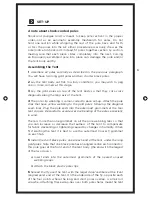
5
Condensation on the Canopy
The polyester canopy fabric absorbs much less water than nylon, so the
inner tent walls will usually feel dryer than nylon would, and, unlike nylon,
will not stretch and sag in damp conditions. MEC’s proprietary Tensilk-HT
TM
polyester is exceptionally strong, yet weighs about the same as no-see-
um mesh. Tensilk-HT gets its strength from an extremely tight weave, so
under very cold conditions (minus 15°C or below) some condensation and
icing may occur on the inside of the canopy. If it does, simply brush off and
sweep out any accumulated frost before packing the tent.
Ultralight Set-up
Using a custom Footprint (available separately), you can erect just the fl y.
This confi guration provides a very light, compact, and basic shelter, and
will dry more quickly in the morning because of better airfl ow. However,
the set-up is not readily bug-proof, it is subject to more condensation
forming on the inside of the fl y, and it does not keep foul weather out as
effectively.
This set-up is easiest with two people. Spread the Footprint out fl at on
the ground. Insert the two long gold poles into the appropriate grommets
at the front and back corners of the Footprint, while one person holds
the two poles steady at the point where they cross. Spread the fl y over the
poles (and the person). Ensure the fl y doors are correctly oriented to the
Footprint, then use the Velcro fasteners at the centre inside top of the fl y to
secure the pole crossing by wrapping around the crossover point. Insert the
two short black poles into the appropriate Footprint grommets, with the
angled pole to the front. Secure them to the gold poles at the four crossing
points using the Velcro strips on the fl y. Attach the remaining Velcro strips
directly to individual poles. Attach the grommet strips at the base of the
fl y to the pole tips, folding them under as for usual set-up. The tent may
be guyed and pegged out as usual. In wind, peg out the Footprint before
beginning. Keep vents and doors open as much as possible to minimize
condensation. Snow, sand, etc. may be piled up or scooped away around
the base of the fl y to vary the airfl ow through the tent. Disturb soil as little
as possible to leave the site untouched for others to enjoy.
Anchoring the Tent
The #7001-T6 aluminum stakes included with the tent are suitable for
general use on relatively soft ground. However, in very hard-packed
ground you will need stronger (and heavier!) stakes that can withstand
the force needed to drive them in. On snow, sand, or other loose-packed
surfaces, wider T-Stakes or aluminum snow stakes will hold better; these
stakes hold best buried horizontally. You can also improvise with other
“stakes” (hiking staffs, ice axes, branches, rocks, trees), using the tent’s
stake loops or cord as required.
Lightfield eng.indd 5
Lightfield eng.indd 5
3/1/05 2:32:26 PM
3/1/05 2:32:26 PM


























